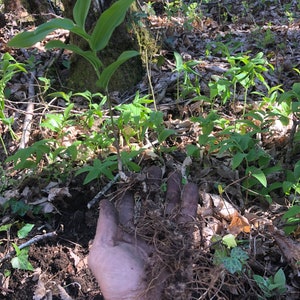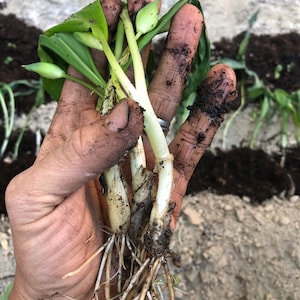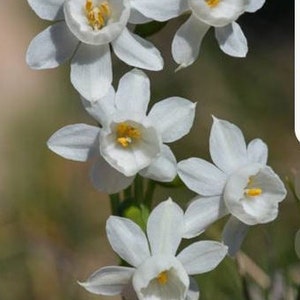
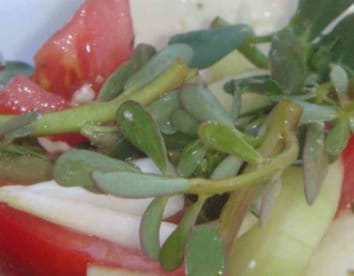
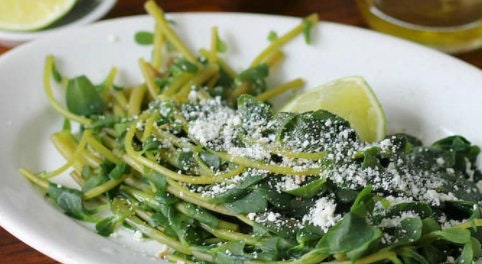
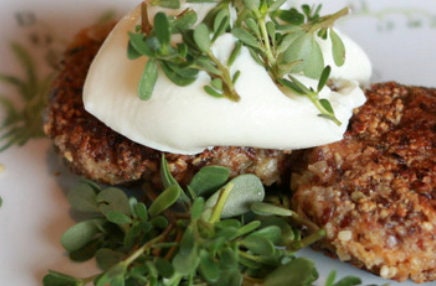

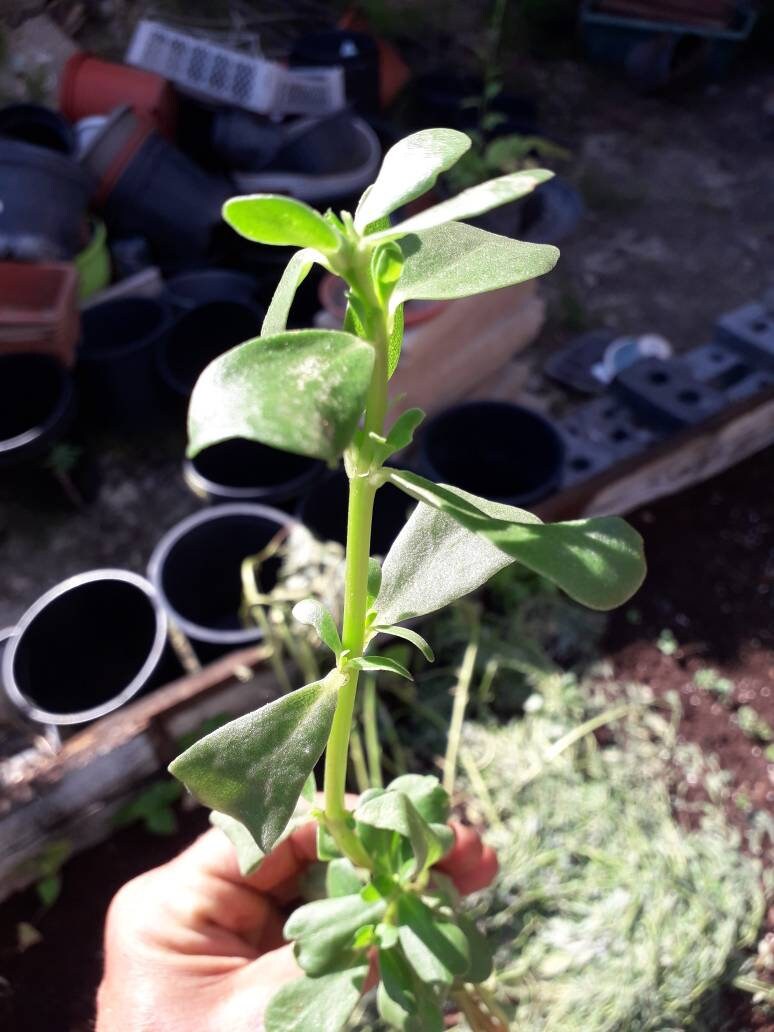
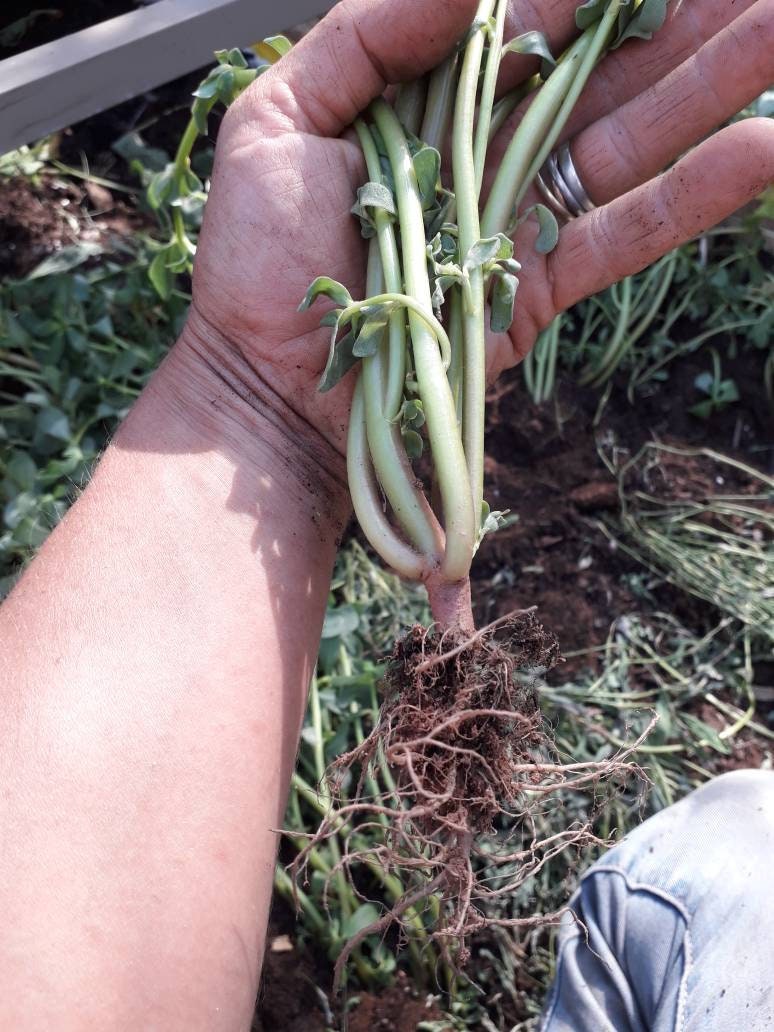
seeds and roots
Purslane plants with established roots superfood vegetable, succulent, drought tolerant food.
$7.32
-
DetailsPurslane (Portulaca oleracea L.) is a delicious vegetable which can be steamed, stir fired, used just like spinach, or eat fresh in salades. The Leafy green is of great importance to vegetarians and vegans.
If you are experiencing any problems during checkout please contact me and we can sort it out. (ie. item it is not available for your area).
It is important also to mention it as a drought tolerant crop! And easily can grow in any substrate even rocky, clay based and otherwise difficult to grow food because of nutrient deficient conditions.
Really I believe that this plant is a plant of the future! full of vitamins, minerals, omega-3 fatty acids, and very medicinal for the digestive tract.
You will receive plants with established roots, because these plants are succulent, they travel very well long distances in the post. They are annual herbaceous, these plants will flower then self seed or you can also make cutting so you can start your own patch quickly get a fast supply of this tasty veggie!!
Purslane is widely distributed around the globe and is popular as a potherb in many areas of Europe, Asia, and the Mediterranean region.
This plant possesses mucilaginous substances which are of medicinal importance.
It is a rich source of potassium (494 mg/100 g) followed by magnesium (68 mg/100 g) and calcium (65 mg/100 g) and possesses the potential to be used as vegetable source of omega-3 fatty acid.
It is very good source of alpha-linolenic acid (ALA) and gamma-linolenic acid (LNA, 18 : 3 w3) (4 mg/g fresh weight) of any green leafy vegetable.
It contained the highest amount (22.2 mg and 130 mg per 100 g of fresh and dry weight, resp.) of alpha-tocopherol and ascorbic acid (26.6 mg and 506 mg per 100 g of fresh and dry weight, resp.).
The oxalate content of purslane leaves was reported as 671–869 mg/100 g fresh weight.
The antioxidant content and nutritional value of purslane are important for human consumption.
It revealed tremendous nutritional potential and has indicated the potential use of this herb for the future!
Purslane (Portulaca oleracea L.) deserves special attention from agriculturalists as well as nutritionists. Purslane has wide acceptability as a potherb in Central Europe, Asia, and the Mediterranean region. It is an important component of green salad and its soft stem and leaves are used raw, alone, or with other greens. Purslane is also used for cooking or used as a pickle. Its medicinal value is evident from its use for treatment of burns, headache, and diseases related to the intestine, liver, stomach, cough, shortness of breath, and arthritis. Its use as a purgative, cardiac tonic, emollient, muscle relaxant, and anti-inflammatory and diuretic treatment makes it important in herbal medicine. Purslane has also been used in the treatment of osteoporosis and psoriasis.
Recent research demonstrates that purslane has better nutritional quality than the major cultivated vegetables, with higher beta-carotene, ascorbic acid, and alpha-linolenic acid. Additionally, purslane has been described as a power food because of its high nutritive and antioxidant properties. Different varieties, harvesting times, and environmental conditions can contribute to purslane's nutritional composition and benefits.
Purslane is popular as a traditional medicine in China for the treatment of hypotension and diabetes. Scientifically, it is not proven to have antidiabetic effects, but still people use it for this purpose. An experiment has been carried out for the extraction of crude polysaccharide(s) from purslane to investigate the hypoglycemic effects of these constituents with animal tests for the use of this plant in the treatment of diabetes.
Purslane is a very good source of alpha-linolenic acid. Alpha-linolenic is an omega-3 fatty acid which plays an important role in human growth and development and in preventing diseases. Purslane has been shown to contain five times higher omega-3 fatty acids than spinach. Omega-3 fatty acids belong to a group of polyunsaturated fatty acids essential for human growth, development, prevention of numerous cardiovascular diseases, and maintenance of a healthy immune system. Our bodies do not synthesise omega-3 fatty acids. Therefore omega-3 fatty acids must be consumed from a dietary source. Omega-3 fatty acids contain 18 to 24 carbon atoms and have three or more double bonds within its fatty acid chain. Fish is the richest source of omega-3 fatty acids. Health authorities highly recommend that we consume fish regularly to meet our bodies' requirements of omega-3 fatty acids, as other sources are limited and do not supply nearly as much omega-3 fatty acids. Purslane has recently been identified as the richest vegetable source of alpha-linolenic acid, an essential omega-3 fatty acid. The lack of dietary sources of omega-3 fatty acids has resulted in a growing level of interest to introduce purslane as a new cultivated vegetable. Purslane flourishes in numerous biogeographical locations worldwide and is highly adaptable to many adverse conditions such as drought, saline, and nutrient deficient conditions.
Distribution. It is reported that purslane was a common vegetable of the Roman Empire. Origin of purslane is not certain, but existence of this plant is reported about 4,000 years ago. The succulent stems and fleshy leaves of purslane reflect that it may have originated and adapted to desert climates of the Middle East and India. It can be found in Europe, Africa, North America, Australia, and Asia.
Botanical Classification. Portulaca oleracea is s cosmopolitan species and the genus Portulaca belongs to the family Portulacaceae, a small family with 21 genera and 580 species, and is cosmopolitan in distribution, occurring especially in America with some species found in Arabia. Purslane plants are succulent, annual herbaceous, and erect or decumbent up to 30 cm high. Purslane is botanically known as Portulaca oleracea and is also called portulaca.
Habitat. It grows well in orchards, vineyards, crop fields, landscaped areas, gardens, roadsides, and other disturbed sites.
Stem. Stems are cylindrical, up to 30 cm long, 2-3 mm in diameter, green or red, swollen at the nodes, smooth, glabrous apart from the leaf axils, and diffusely branched, and the internodes are 1.5–3.5 cm in length.
Leaf. Purslane leaves are alternate or subopposite, flat, fleshy, having variable shapes, obovate, 1–5 cm long, 0.5–2 cm across, obtuse or slightly notched at the apex, tapering at base, sessile or indistinctly petiolate, glabrous, smooth, and waxy on the upper surface, with entire margin, small stipules, and cluster of hairs up to 1 mm long. Leaves are egg to spatula shaped, succulent, and stalkless or have very short stalks, about 5–30 mm long, and sometimes their edges are red-tinged. Leaves are green or green with red margin.
Seedling. Cotyledons (seed leaves) are egg shaped to oblong, hairless, succulent, about 2–5 mm long, and sometimes tinged red.
Flower. Flowering initiates during May to September. Flowers originate as single or clusters of two to five at the tips of stems. The flowers are minute or small having orange yellow, purple, or white pink color with five petals and typically open only on hot and sunny days from mid-morning to early afternoon.
Fruit. Fruit consists of almost round to egg-shaped capsules, usually about 4–8 mm long that open around the middle to release the seeds. Seeds are tiny, less than 1 mm in diameter, circular to egg shaped, flattened, and brown to black with a white point of attachment. Numerous seeds are produced.
Purslane is one of the richest green plant sources of omega-3 fatty acids. It has lower the cholesterol and triglyceride levels, raise the beneficial high density lipoprotein. Moreover, the ability of omega-3 fatty acids to decrease the thickness of the blood may be advantageous in the treatment of vascular diseases. Unlike fish oils with their high cholesterol and calorie content, purslane also provides an excellent source of the beneficial omega-3 fatty acids without the cholesterol of fish oils, since it contains no cholesterol. There are 3 varieties of purslane, namely, the green, golden, and a large-leaved golden variety.
Purslane (Portulaca oleracea) (Nutritive value per 100 g).
Principle Nutrient value Percentage of RDA
Energy 16 Kcal 1.5%
Carbohydrates 3.4 g 3%
Protein 1.30 g 2%
Total Fat 0.1 g 0.5%
Cholesterol 0 mg 0%
Vitamins
Folates 12 μg 3%
Niacin 0.480 mg 3%
Pantothenic acid 0.036 mg 1%
Pyridoxine 0.073 mg 5.5%
Riboflavin 0.112 mg 8.5%
Thiamin 0.047 mg 4%
Vitamin A 1320 IU 44%
Vitamin C 21 mg 35%
Electrolytes
Sodium 45 mg 3%
Potassium 494 mg 10.5%
Minerals
Calcium 65 mg 6.5%
Copper 0.113 mg 12.5%
Iron 1.99 mg 25%
Magnesium 68 mg 17%
Manganese 0.303 mg 13%
Phosphorus 44 mg 6%
Selenium 0.9 μg 2%
Zinc 0.17 mg 1.5% -
Shipping & Policies
Shipping from France
Processing time
1-3 business days
Customs and import taxes
Buyers are responsible for any customs and import taxes that may apply. I'm not responsible for delays due to customs.
Payment Options
Returns & Exchanges
I gladly accept returns, exchanges, and cancellations
Just contact me within: 14 days of delivery
Ship items back to me within: 30 days of delivery
- Custom or personalized orders
- Perishable products (like food or flowers)
- Digital downloads
- Intimate items (for health/hygiene reasons)
- Items on sale
Conditions of return
Buyers are responsible for return shipping costs. If the item is not returned in its original condition, the buyer is responsible for any loss in value.
Questions about your order?
Please contact me if you have any problems with your order.
